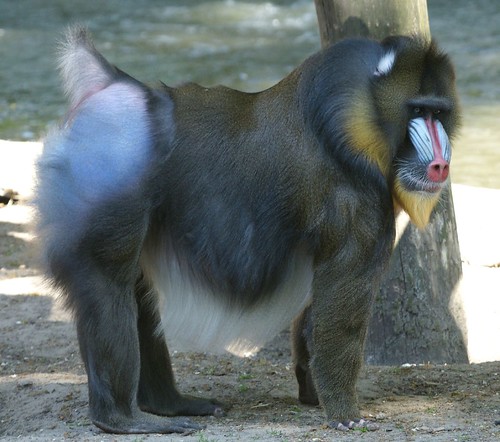Post by dinosauria101 on May 11, 2019 7:37:22 GMT 5
Mandrill - Mandrillus sphinx
The mandrill (Mandrillus sphinx) is a primate of the Old World monkey (Cercopithecidae) family, closely related to the baboons and even more closely to the drill. It is found in southern Cameroon, Gabon, Equatorial Guinea, and Congo. Mandrills mostly live in tropical rainforests and forest-savanna mosaics. They live in groups called "hordes". Mandrills have an omnivorous diet consisting mostly of fruits and insects. Their mating season takes place from June to October. Males average 25–35 kg (55-77 lb); females are less than half that weight (11–14 kg, or 25-30 lb). Unusually large males can weigh 50 kg (110 lb). The average male is 81–90 cm (32–36 in) and the female is 56–66 cm (22–26 in), with the tail adding another 5–8 cm (2–3 in). They can survive up to 31 years in captivity. Females reach sexual maturity at about 3.5 years. The mandrill has one of the greatest sexual dimorphisms among the primates.

African Rock Python - Python sebae
Python sebae, commonly known as the African rock python, is a large, nonvenomous snake of Sub-Saharan Africa. The African rock python is one of seven species in the genus Python. It has two subspecies: one found in Central and Western Africa, the other in Southern Africa. Africa's largest snake species and one of the world's largest, the typical African rock python adult measures 3 to 3.53 m (9 ft 10 in to 11 ft 7 in) in total length (including tail), with only unusually large specimens likely to exceed 4.8 m (15 ft 9 in). Reports of specimens over 6 m (19 ft 8 in) are considered reliable, although larger specimens have never been confirmed. Weights are reportedly in the range of 44 to 55 kg (97 to 121 lb), per one study adults are expected to weigh only up to 32.2 kg (71 lb). The southern subspecies is generally smaller than its northern relative. The animal has a pattern of colored blotches on its body. It has dual lungs and vestigial hind limbs, which show it is less advanced in evolution than other snakes. The snake is found in a variety of habitats, from forests to near deserts, although usually near sources of water. The African rock python kills its prey by constriction and often eats animals up to the size of antelope, occasionally even crocodiles. The snake reproduces by egg-laying. Unlike most snakes, the female will protect her nest and sometimes even her hatchlings. The snake is widely feared even though it only very rarely kills humans. Although the snake is not endangered, it does face threats from habitat reduction and hunting.

Credit to Wikipedia
The mandrill (Mandrillus sphinx) is a primate of the Old World monkey (Cercopithecidae) family, closely related to the baboons and even more closely to the drill. It is found in southern Cameroon, Gabon, Equatorial Guinea, and Congo. Mandrills mostly live in tropical rainforests and forest-savanna mosaics. They live in groups called "hordes". Mandrills have an omnivorous diet consisting mostly of fruits and insects. Their mating season takes place from June to October. Males average 25–35 kg (55-77 lb); females are less than half that weight (11–14 kg, or 25-30 lb). Unusually large males can weigh 50 kg (110 lb). The average male is 81–90 cm (32–36 in) and the female is 56–66 cm (22–26 in), with the tail adding another 5–8 cm (2–3 in). They can survive up to 31 years in captivity. Females reach sexual maturity at about 3.5 years. The mandrill has one of the greatest sexual dimorphisms among the primates.

African Rock Python - Python sebae
Python sebae, commonly known as the African rock python, is a large, nonvenomous snake of Sub-Saharan Africa. The African rock python is one of seven species in the genus Python. It has two subspecies: one found in Central and Western Africa, the other in Southern Africa. Africa's largest snake species and one of the world's largest, the typical African rock python adult measures 3 to 3.53 m (9 ft 10 in to 11 ft 7 in) in total length (including tail), with only unusually large specimens likely to exceed 4.8 m (15 ft 9 in). Reports of specimens over 6 m (19 ft 8 in) are considered reliable, although larger specimens have never been confirmed. Weights are reportedly in the range of 44 to 55 kg (97 to 121 lb), per one study adults are expected to weigh only up to 32.2 kg (71 lb). The southern subspecies is generally smaller than its northern relative. The animal has a pattern of colored blotches on its body. It has dual lungs and vestigial hind limbs, which show it is less advanced in evolution than other snakes. The snake is found in a variety of habitats, from forests to near deserts, although usually near sources of water. The African rock python kills its prey by constriction and often eats animals up to the size of antelope, occasionally even crocodiles. The snake reproduces by egg-laying. Unlike most snakes, the female will protect her nest and sometimes even her hatchlings. The snake is widely feared even though it only very rarely kills humans. Although the snake is not endangered, it does face threats from habitat reduction and hunting.

Credit to Wikipedia


